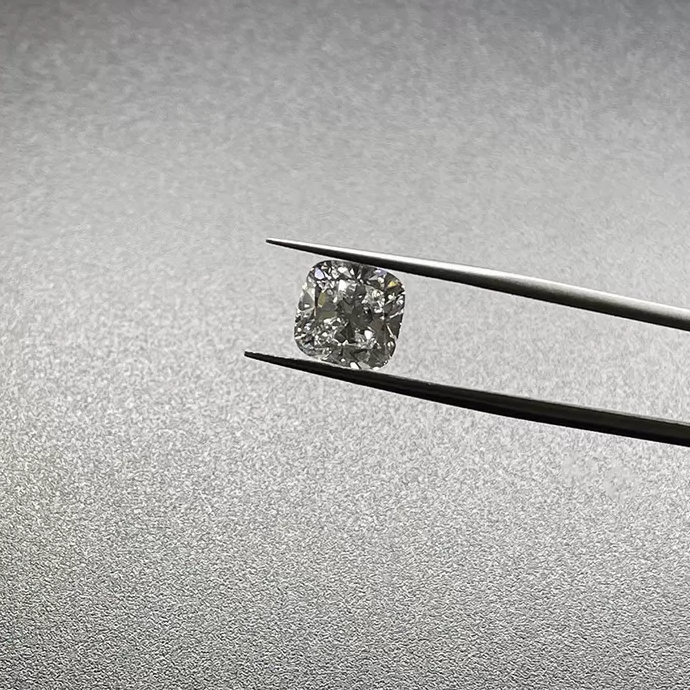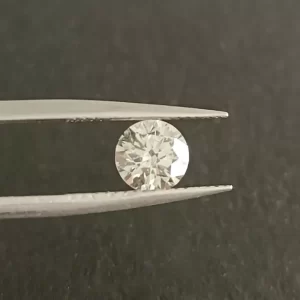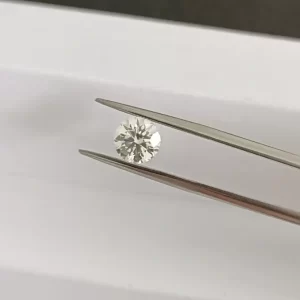Type 2A EFG VVS VS Fancy Cut Lab Grown Diamonds CVD 2 Carat
2 Carat Type 2A EFG Color VVS VS Clarity Fancy Cut Lab Grown Diamonds Made By CVD Method
Fancy Cut Lab Diamonds Description
Lab diamonds are real diamonds. Carbon is the main element of natural and laboratory-grown diamonds. The chemical and physical properties of synthetic diamonds are same as natural diamonds in terms of hardness, thermal conductivity, and strength. After polishing it’s difficult to distingush lab diamonds and natural diamond by naked eyes.
Round cut is the most common cut. Fancy shaped lab diamond, also known as gardener cut diamond, refers to diamonds other than standard round diamonds. The common fancy shape lab diamonds include pear shaped, marquise shaped, princess, radiant, emerald cut, heart, oval shape, etc.
Princess cutting is one of the fancy cut diamonds. Its advantage is that it can make full use of the rough diamond and make the diamond look 10% to 15% larger than the round diamond.
Like round diamond, Princess diamond has 57 or 58 facets, which is also a way to make the diamond reflect the best brightness; The diamond crown has 33 faces, the bottom has 24 / 25 faces, the princess square crown has 20 faces, and the bottom has 37 / 38 faces; The cutting is unique. Under the same score, the table of Princess cut is larger than Round cut.
The fire of Princess diamond is not inferior to round diamond. Because Princess diamond is square, people’s visual points are scattered to the four corners of square diamond, while the visual points of round diamond are concentrated in the middle, and the crown facet is less than that of round diamond, which makes it easier for light to enter into the diamond. The facet of Pavilion is more than that of round diamond, which makes the light entering the diamond refract at more angles.
Type 2A EFG VVS VS Fancy Cut Lab Grown Diamonds CVD 2 Carat
Tidbits about Fancy Cut lab-grown diamonds
Fancy Cut Lab Grown Diamonds
Considering buying a fancy cut lab grown diamond? Then read this article to learn more. We’ll discuss the Pear Brilliant Cut, Emerald Cut, and Canary Yellow cuts. You’ll also learn about the different types of stones available in these labs. And since lab grown diamonds are so rare and beautiful, why not try one? And if you don’t know where to start, we’ve provided links to several online retailers that sell fancy cut diamonds.
Pear Brilliant Cut
When it comes to choosing a lab diamond, a pear brilliant cut will suit you perfectly. This modified brilliant cut combines the sparkle of a round diamond with the finger-flattering shape of a marquise. This shape is ideal for fine jewelry, engagement rings, pendants, and earrings, and is often paired with smaller round diamonds for a stunning effect. Read on to discover why the pear brilliant cut is so popular and how you can get it.
A pear-shaped lab grown diamond is often set in a halo or solitaire setting, enhancing its sparkle. However, because pear-shaped diamonds have a pointy tip, they are susceptible to chipping. It’s important to choose a setting that protects this part of the diamond. Another difference between pear-shaped and pear-cut diamonds is that lab grown diamonds are just as brilliant as the ones mined from earth. They are so identical that a trained gemologist can’t tell the difference.
Pear-shaped diamonds have similar facets to round brilliant cuts, making them easy to cut and set. This cut maximizes light performance and makes the stone look larger than it really is. Pear-shaped diamonds have many facets, so they can hide inclusions near the point while giving a bigger, more dramatic look than other fancy shapes. The shape is also perfect for engagement rings, and many celebrities wear them.
A pear diamond should be set with the prong at the point, as this is the location where chipping will most likely occur. The point was once the outer edge of the rough stone. A pear diamond may also contain inclusions or other flaws. While these flaws will not be visible when set, they will affect the stability of the stone. This chart can help you choose the right cut for your stone.
A pear diamond can have a high-quality cut grade, but its fragile tip is difficult to make a mistake. The tip of the diamond will be vulnerable to wear, and the diamond will have a bowtie-like effect that can be disguised with a high-quality cut grade. A pear diamond should have excellent symmetry, but the proportion of the facets will vary depending on the cut and the preference of the buyer.
A pear diamond can have different qualities, and the cut quality is not always determined by the certificate. A few pear shapes have a box-like shape with curved sides, and some are more rectangular, sloped towards the point in a rounded manner. Another factor to consider is the clarity of the stone. It should be of a high enough quality that you can see it with the naked eye.
Depending on the cut of a diamond, a pear may be darker toward the point than the rest of the stone. The point of the stone can be hidden with a larger pear diamond. A higher color grade will also reduce the appearance of this darkening. Despite the heightened color grade of pear diamonds, it’s difficult to see the difference between these two categories with the naked eye.
Emerald Cut
When choosing a perfect diamond for your engagement ring, consider the Emerald Cut fancy cut lab grown diamonds. They are a beautiful alternative to traditional diamonds, and come with many advantages, including purity and durability. Emerald cut diamonds are one of the most popular choices because of their dazzling beauty and brilliance. They’re also affordable. In addition to their beauty, Emerald cut diamonds are available in a wide variety of colors and carat weights, including an exceptional VS2 clarity rating.
This popular shape is characterized by its open table and step-cut facets. Emerald cut lab diamonds have less faceting than other diamond shapes, creating a “hall of mirrors” effect. Emerald cut diamonds look elegant and are ideal for various types of settings. Here are some of the benefits of Emerald Cut lab diamonds. They have an excellent color range, allowing buyers to choose between yellow, pink, or white diamonds.
The Emerald Cut is another popular shape for a fancy cut diamond. This shape is a step cut, as opposed to a brilliant cut. It gives the diamond a hall-of-mirrors effect, which makes it a perfect choice for displaying color and clarity. Emerald cut diamonds are popular as engagement rings, as they appear larger than other diamond shapes of the same carat weight. The rectangular shape also makes it easier to see the center of the stone.
In terms of cut, an Emerald Cut is a classic vintage cut. This diamond cut is characterized by a limited number of facets, but its sparkle is unparalleled. Emerald Cut diamonds should have a clarity of VS2 or better. In addition, Emerald Cut diamonds have a timeless appeal. Aside from the Emerald Cut, oval cuts are becoming popular and gaining popularity. These diamonds can be set in many different styles and have a wide range of settings.
Aside from being a beautiful gemstone, Emerald Cut fancy cut lab grown diamonds are also affordable. Emerald cut diamonds are typically priced 30 to 50 percent less than natural diamonds. The emerald cut has become synonymous with fashion and aristocratic style. While they don’t have the same luster as a natural diamond, Emerald Cut lab grown diamonds possess the same physical and chemical characteristics. These properties make them a popular choice for engagement rings.
While the emerald is one of the most transparent diamond shapes, inclusions will appear more readily if they are placed in the center. This makes VS1 clarity an excellent compromise. In addition, emeralds should be able to keep their value over time, and VS2 clarity is ideal for a fancy cut emerald. For most emerald cuts, the stone should have VS1 clarity or better.
Canary Yellow
Canary Yellow fancy cut diamonds have a deep and intense yellow color. This hue is rare in nature, but can be easily produced in a lab. This means you can afford to purchase vivid yellow diamond rings. The price of these diamonds is more affordable than you think. Let’s find out how these gems are created and how to purchase one. There are two basic ways to buy one. The first is to check its GIA rating and read about its characteristics. This way, you can be sure that you’re buying a high-quality Canary Yellow diamond.
The GIA color grading system assigns a letter grade to diamonds with a yellow hue. This diamond grade is different from ordinary diamonds, which are graded on a scale of D to Z. It also rates the intensity of the color. Fancy Yellow diamonds are more saturated than regular yellow diamonds and are graded higher than Z. These diamonds are rare and sought-after, and the price is much lower than for natural diamonds.
If you’re looking to buy a Canary Yellow fancy cut diamond, you’ll want to go with a trustworthy jeweler. James Allen carries a large selection of lab-grown diamonds, with over 3400 options available in loose form. The website also allows you to filter by clarity, intensity, carat weight, and even diamond shape. This way, you can find a perfect match for any budget.
Canary Yellow fancy cut lab diamonds are the perfect choice for an engagement ring. These diamonds are a stunning option and can be one-third less expensive than natural ones. The same atomic makeup and sparkle of natural diamonds make them desirable. Canary Yellow fancy cut diamonds are the latest trend in diamond jewelry, and Mayfair Jewelers is proud to offer these gems at a fraction of the price of comparable natural diamonds.
Buying a Canary Yellow diamond is not a cheap option, however. As with any other fancy cut diamond, the price of a canary diamond depends on its hue. The more intense the yellow, the more expensive the diamond. A canary yellow diamond will cost $4000 per carat, while a white diamond will cost less than $3000. You will also need to look for a diamond with minimal fluorescence.
While the price of a Canary Yellow fancy cut lab grown diamond varies depending on the carat, the prices tend to increase with carat weight. For a one-carat diamond, the cost is not too high. However, when buying a 1.5-carat or even a four-carat diamond, the price can be higher. Make sure the lab grown yellow diamond you buy is eye clean. Inclusions happen during the diamond’s formation, but are less obvious in lab-grown gems. Eye-clean lab grown diamonds typically have a SI clarity rating.
Type 2A EFG VVS VS Fancy Cut Lab Grown Diamonds CVD 2 Carat

















